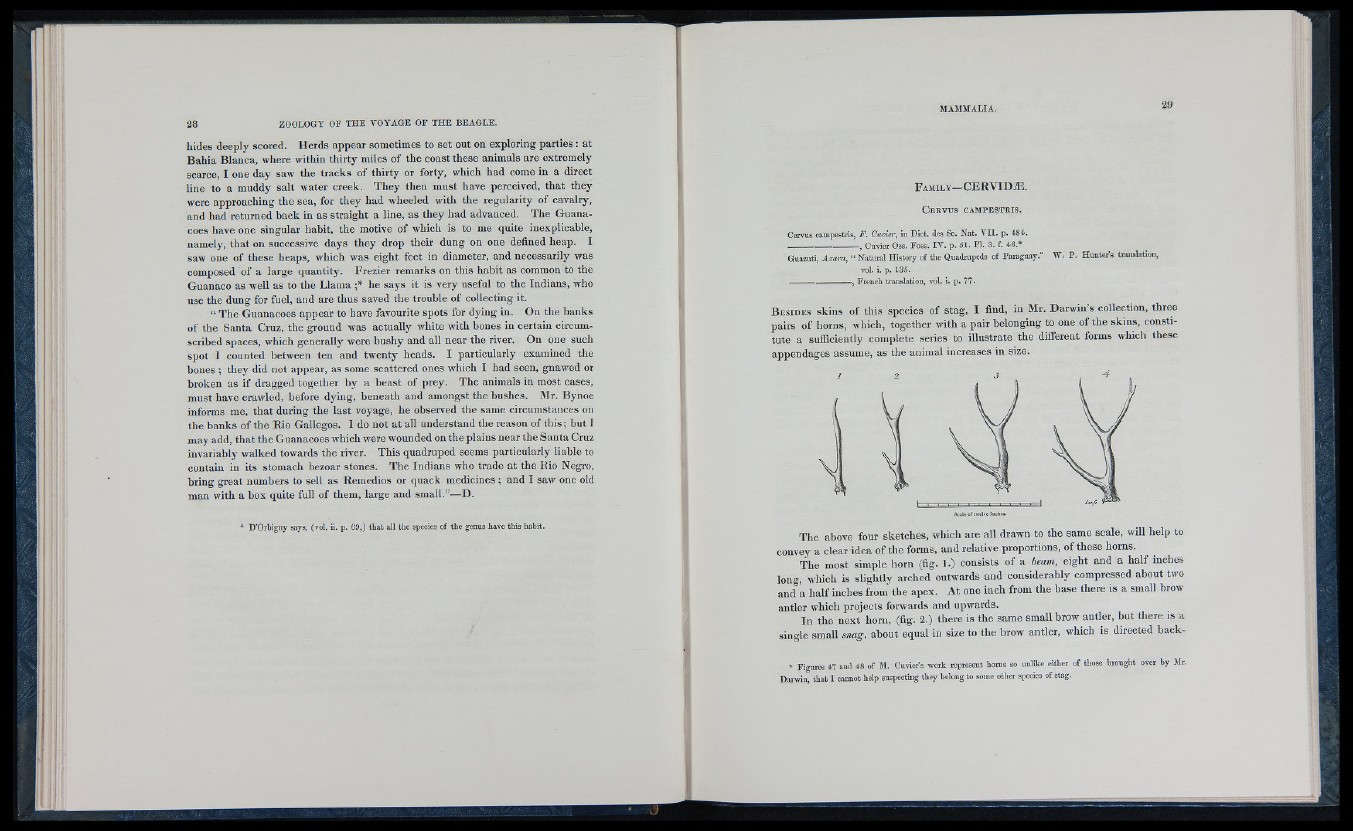
hides deeply scored. Herds appear sometimes to set out on exploring parties : at
Bahia Blanca, where within thirty miles of the coast these animals are extremely
scarce, I one day saw the tracks of thirty or forty, which had come in a direct
line to a muddy salt water creek. They then must have perceived, that they
were approaching the sea, for they had wheeled with the regularity of cavalry,
and had returned back in as straight a line, as they had advanced. The Guanacoes
have one singular iiabit, the motive of which is to me quite inexplicable,
namely, that on successive days they drop their dung on one defined heap. I
saw one of these heaps, which was eight feet in diameter, and necessarily was
composed of a large quantity. Frezier remarks on this habit as common to the
Guanaco as well as to the Llama ;* he says it is very useful to the Indians, who
use the dung for fuel, and are thus saved the trouble of collecting it.
“ The Guanacoes appear to have favourite spots for dying in. On the banks
of the Santa Cruz, the ground was actually white with bones in certain circumscribed
spaces, which generally were bushy and all near the river. On one such
spot I counted between ten and twenty heads. I particularly examined the
hones ; they did not appear, as some scattered ones which I had seen, gnawed or
broken as if dragged together by a beast of prey. The animals in most cases,
must have crawled, before dying, beneath and amongst the hushes. Mr. Bynoe
informs me, that during the last voyage, he observed the same circumstances on
the banks of the Rio Gallegos. I do not at all understand the reason of this; but I
may add, that the Guanacoes which were wounded on the plains near the Santa Cruz
invariably walked towards the river. This quadruped seems particularly liable to
contain in its stomach bezoar stones. The Indians who trade at the Rio Negro,
bring great numbers to sell as Remedies or quack medicines ; and I saw one old
man with a box quite full of them, large and small.”—D.
' D ’Orbigny says, (vol. ii. p. 69,) th at all the species of the genus have this habit.
F amily-C E R V ID ,E .
C e r v u s c a m p e s t r i s .
Cervus campestris, F . Cuvier, in Diet, des Sc. N at. V II. p. 484.
___________________ J Cuvier Oss. Foss. IV . p. 51. PI. 3. f. 46.*
Guaauti, A z m , “ N atural H istory of tlio Quadrupeds of Paraguay." W . P . H unter's translation,
vol. i. p. 135.
------------------------- French translation, vol. i. p. 77.
B e s i d e s skins of this species of stag, I find, in Mr. Darwin’s collection, three
pairs of horns, which, together with a pair belonging to one of the skins, constitute
a sufficiently complete series to illustrate the different forms which these
appendages assume, as the animal increases in size.
The above four sketches, which are all drawn to the same scale, will help to
convey a clear idea of the forms, and relative proportions, of these horns.
The most simple horn (fig. 1.) consists of a beam, eight and a half inches
long, which is slightly arched outwards and considerably compressed about two
and a half inches from the apex. At one inch from the base there is a small brow
antler which projects forwards and upwards.
In the next horn, (fig. 2.) there is the same small brow antler, but there is a
single small snag, about equal in size to the brow antler, which is directed back-
* Figures 47 and 48 of 51. Cuviers work represent horns so unlike either of those brought over by 5Ir.
Darwin, that I cannot help suspecting they belong to some other species of stag.